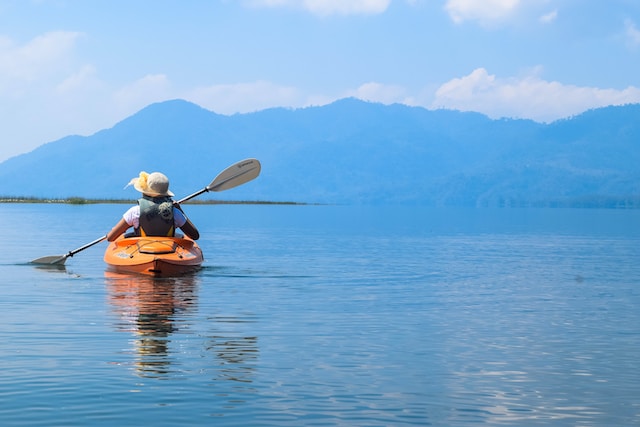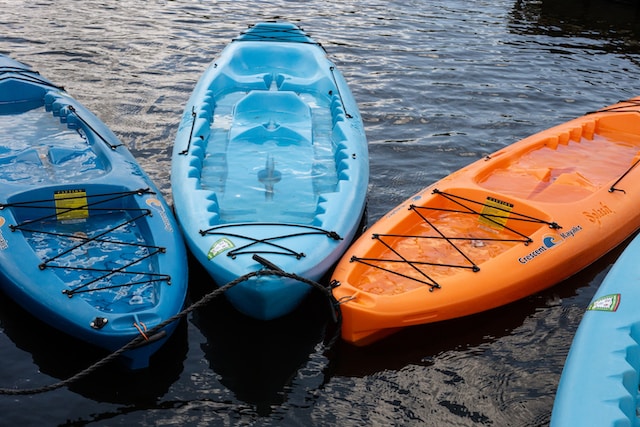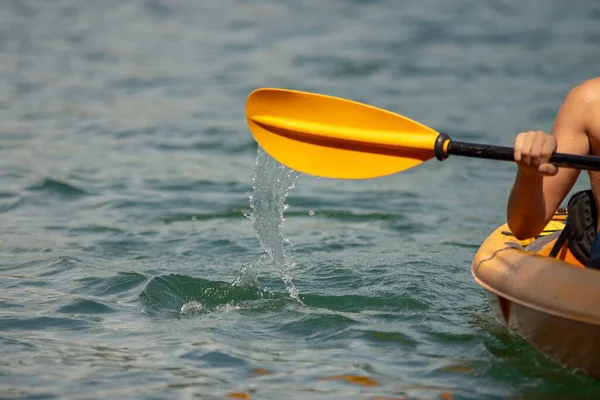What Size Kayak Do I Need? – A Comprehensive Guide
What Size Kayak Do I Need?
Choosing the right size kayak is crucial for a comfortable and enjoyable paddling experience. Whether you’re a seasoned kayaker or a beginner looking to explore the waterways, selecting the appropriate kayak size will ensure stability, maneuverability, and ease of use.

Factors such as your body type, paddling style, intended use, and skill level all play a role in determining the ideal kayak size for you.
In this article, we will explore the key considerations to help you determine what size kayak you need, allowing you to make an informed decision before hitting the water.
- What Size Kayak Do I Need?
- Kayak Sizes and Types
- Assessing Your Kayaking Needs
- What Size Kayak Do I Need for My Body Type
- Kayak Size Impact on Stability and Performance
- the Water Conditions
- Kayak Weight Capacity: A Critical Factor
- Solo vs Tandem Kayaks
- Children and Youth Kayak Sizing
- Tips for Testing and Selecting the Right Kayak Size
- Conclusion
- Frequently Asked Questions
Kayak Sizes and Types
In order to choose the right kayak, it is essential to understand the various sizes and types available.
Kayak sizes are determined by key dimensions such as length, width, and cockpit size. These dimensions can vary based on the type of kayak.
Kayak Dimensions Explained
Kayak dimensions play a crucial role in determining the performance and suitability of the kayak for specific activities.
The length of a kayak affects its speed and tracking capabilities, with longer kayaks offering better speed but potentially sacrificing maneuverability.
Width and hull shape, on the other hand, determine the balance between stability and maneuverability. The cockpit size determines the comfort and fit for the paddler.
Different Types of Kayaks and Their Typical Sizes
There are various types of kayaks designed for different activities.
Recreational kayaks are typically shorter and wider, offering stability and ease of use for casual paddling.
Touring kayaks, on the other hand, are longer and narrower, optimized for speed and extended trips.
Fishing kayaks have specialized features such as rod holders and storage compartments. Whitewater kayaks are designed to withstand the rigors of fast-moving rivers and come in different sizes for specific skill levels and water conditions.
Importance of Kayak Volume and Capacity
Another crucial factor to consider when choosing a kayak is its volume and weight capacity.
Kayak volume refers to the internal space inside the kayak, which affects its buoyancy and stability.

It is essential to select a kayak with adequate volume to ensure stability in different water conditions.
The weight capacity of a kayak determines the maximum weight it can safely carry, including the paddler, gear, and any additional equipment.
Exceeding the weight capacity compromises the kayak’s stability and safety.
Assessing Your Kayaking Needs
In order to find the right size kayak, it is important to assess your specific kayaking needs.
Consider the differences between recreational and touring kayaks, as well as your preferred kayaking activities, and the storage and transportation limitations you may have.
Recreational vs. Touring Kayak
When choosing a kayak size, you need to understand the key differences between recreational and touring kayaks.
Recreational kayaks are generally shorter and wider, providing stability and ease of maneuverability.
They are ideal for leisure paddling and calm waters. On the other hand, touring kayaks are longer and narrower, offering greater speed and tracking capabilities.
They are designed for longer journeys and more advanced paddling techniques. Consider your skill level and the type of kayaking you plan to do when deciding between recreational and touring kayaks.
Identifying Your Preferred Kayaking Activities
Identifying your preferred kayaking activities will help determine the appropriate kayak size.
If you enjoy leisurely paddling on calm waters, a smaller recreational kayak may be suitable.
If you plan on overnight trips or adventures in rougher waters, a larger touring kayak with increased stability and storage capacity may be more appropriate.
Think about the activities you enjoy most and choose a kayak size that aligns with those interests.
Storage and Transportation Limitations
It is important to consider your storage and transportation limitations when selecting a kayak size.
If you have limited space at home or need to transport your kayak frequently, a smaller, more compact kayak may be more practical.
Look for kayaks that are lightweight and easy to handle for convenient storage and transportation.
Additionally, consider the available storage and transportation options in your area to ensure the kayak size you choose is compatible with your needs.
What Size Kayak Do I Need for My Body Type
When it comes to choosing the right kayak size, considering your body type is crucial for a comfortable and enjoyable paddling experience.
Factors such as height, weight, and leg length can significantly impact the fit and performance of a kayak.

To determine the appropriate kayak length, consider your height.
Taller individuals typically require longer kayaks to ensure adequate legroom and stability.
On the other hand, shorter individuals may opt for a shorter kayak for easier maneuverability.
Your weight is another important consideration.
Heavier individuals may need a kayak with a higher weight capacity to ensure stability and prevent the kayak from sitting too low in the water.
Conversely, lighter individuals may prefer a kayak with a lower weight capacity for better responsiveness.
Leg length plays a role in determining the cockpit size.
If you have longer legs, you may need a kayak with a larger cockpit opening to accommodate your leg length comfortably.
This will prevent your knees from feeling cramped and allow for easier entry and exit from the kayak.
It’s worth noting that these guidelines are general recommendations, and individual preferences can vary.
It’s always a good idea to try out different kayak sizes to see which one best suits your body type and provides the desired level of comfort and stability.
Kayak Size Impact on Stability and Performance
When it comes to kayaking, the size of your kayak can have a significant impact on its stability and performance on the water.
In this section, we will explore how different aspects of kayak size affect these crucial factors.
How Length Affects Kayak Speed and Tracking
The length of a kayak plays a vital role in determining its speed and tracking abilities.
Longer kayaks tend to have better speed, allowing you to cover greater distances with ease.
They also track well, meaning they maintain their course and require less effort to paddle in a straight line.
However, it’s worth noting that longer kayaks may sacrifice maneuverability, making them less ideal for navigating tight spaces or turbulent waters.
Width and Hull Shape: Balancing Stability with Maneuverability
The width and hull shape of a kayak are crucial factors in balancing stability and maneuverability.
Wider kayaks offer greater stability on the water, making them ideal for beginners or those looking for a more relaxed paddling experience.
On the other hand, narrower kayaks provide enhanced maneuverability, allowing for quick turns and better control in rough water conditions.
The hull shape, such as flat-bottomed or V-shaped, also influences stability and maneuverability, with flat-bottomed kayaks offering more initial stability and V-shaped hulls providing better performance in choppy waters.
Personal Comfort: Cockpit Size and Ergonomics
Personal comfort plays a significant role in enjoying your kayaking experience.
The size of the kayak’s cockpit and its ergonomic features are essential considerations.
A properly sized cockpit ensures a snug fit, preventing excess movement and improving overall control.
Additionally, ergonomic features like padded seats, adjustable footrests, and backrests can enhance comfort and reduce fatigue during long paddling sessions.
the Water Conditions
When choosing the right kayak size, it is crucial to consider the water conditions in which you will be paddling.
The kayaking environment can vary from calm waters to rough waters, and each condition requires a different kayak size to ensure optimal performance and safety.
In calm waters, such as lakes or slow-moving rivers, larger kayaks with more stability are typically preferred.
These kayaks offer a smoother and more relaxed paddling experience, perfect for leisurely exploration or fishing trips.
On the other hand, if you plan to venture into rough waters, such as open ocean or fast-moving rivers, smaller and more maneuverable kayaks are recommended.
These kayaks allow for better control and stability in challenging conditions, ensuring that you can navigate through waves and currents with ease.
By considering the water conditions and matching it with the appropriate kayak size, you can maximize your enjoyment and safety while out on the water.
Kayak Weight Capacity: A Critical Factor
When it comes to choosing a kayak, understanding the weight capacity is a critical factor for both safety and performance.
Manufacturers provide weight capacity ratings to ensure that kayakers stay within safe limits while on the water.

Understanding Manufacturer’s Weight Capacity Ratings
The manufacturer’s weight capacity rating is an important specification to consider when selecting a kayak.
This rating indicates the maximum weight a kayak can safely support without compromising its stability and buoyancy.
It’s crucial to pay attention to the manufacturer’s weight capacity rating as exceeding this limit can negatively impact the kayak’s performance and increase the risk of capsizing or sinking.
Calculating Your Gear and Personal Weight
Before hitting the water, it’s essential to calculate your gear and personal weight to ensure that you stay within the recommended limits.
This includes considering the weight of any equipment or accessories you plan to bring along on your kayaking adventures.
To calculate your gear and personal weight accurately, simply add up the weight of all the items you plan to bring, including your own body weight.
This total weight should not exceed the kayak’s weight capacity rating.
Related:
- KAYAKING SAFETY: THE IMPORTANCE OF WEARING A LIFE JACKET
- IMPACT OF WEATHER CONDITIONS ON KAYAK SAFETY
- WILL YOU GET WET WHILE KAYAKING? – A FRIENDLY GUIDE
Safety Considerations for Weight Capacity
Adhering to the weight capacity rating is vital for your safety on the water.
Exceeding the weight capacity can result in reduced stability and maneuverability, making it more challenging to control the kayak.
It’s important to understand that the weight capacity rating takes into account more than just your body weight.
It also considers factors such as water conditions, gear weight, and the distribution of weight within the kayak.
Failing to adhere to the weight capacity could increase the risk of accidents or even lead to the kayak sinking.
When choosing a kayak, always ensure that you select a model with a weight capacity that comfortably accommodates your gear and personal weight.
By doing so, you can enjoy a safe and enjoyable paddling experience on the water.
Solo vs Tandem Kayaks
When choosing a kayak, one important decision to make is whether to go solo or opt for a tandem kayak.
Solo kayaks are designed for individual use, while tandem kayaks are meant to be paddled by two people.

Understanding the differences between these two options and considering your specific needs and preferences will help you make an informed decision.
Advantages of Solo Kayaks:
- Solo kayaks are typically smaller and lighter, making them easier to maneuver and transport.
- They offer greater independence and the freedom to paddle at your own pace and explore at your leisure.
- Solo kayaks are often more responsive, allowing for quick and nimble movements on the water.
Disadvantages of Solo Kayaks:
- Solo kayaks have limited weight capacity and storage space, so they may not be suitable for longer trips or carrying a lot of gear.
- Paddling solo for extended periods can be tiring, requiring more physical effort to cover longer distances.
Advantages of Tandem Kayaks:
- Tandem kayaks offer the opportunity to share the paddling experience with a partner, friend, or family member.
- They provide increased stability and weight capacity, allowing for longer journeys and more gear.
- It’s a great option for beginners or those who prefer the company and teamwork of kayaking with a partner.
Disadvantages of Tandem Kayaks:
- Tandem kayaks are larger and heavier, which can make them more challenging to maneuver, especially in tight spaces or rough conditions.
- There may be conflicts in paddling rhythm and direction, requiring effective communication and coordination with your partner.
Ultimately, the choice between a solo kayak and a tandem kayak depends on your personal preferences, intended use, and the paddling experience you desire.
Consider factors such as size, weight, maneuverability, and the companionship or independence you seek when making your decision.
Children and Youth Kayak Sizing
When it comes to kayaking with children and youth, selecting the right size kayak is essential.
Not only does it ensure their safety, but it also enhances their overall paddling experience.

In this section, we will provide you with guidelines on how to choose the appropriate kayak size that allows room for growth, prioritize safety and comfort, and explore the benefits of kid-friendly kayaks with adjustable features.
Selecting the Right Size for Growing Paddlers
As children and youth are still growing, it’s crucial to find a kayak size that accommodates their current and future needs.
Consider their height, weight, and leg length when determining the proper size.
Opt for kayaks with adjustable footrests, ensuring their legs are comfortably positioned and have room to grow.
Additionally, choose a kayak length and cockpit size that allows for easy entry and exit and provides sufficient space for movement.
Safety and Comfort for Young Kayakers
Prioritizing safety and comfort is paramount when selecting a kayak for children and youth.
Look for kayaks with secure and comfortable seating arrangements, such as adjustable seats with padded backrests.
Ensure that the kayak’s design provides stability to minimize the risk of tipping over, especially for young and less experienced paddlers.
Consider kayaks with molded-in features, such as a stable hull design and wider widths, which provide added stability and instill confidence in young kayakers.
Adjustable Features for Kid-Friendly Kayaks
Kid-friendly kayaks with adjustable features offer great versatility and longevity.
Look for kayaks with adjustable footrests that can accommodate growing legs, allowing children and youth to maintain proper paddling posture.
Additionally, kayaks with adjustable seats provide flexibility in positioning, ensuring optimal comfort and support.
These adjustability features allow the kayak to adapt as young paddlers grow, extending the lifespan of the kayak and enhancing their overall kayaking experience.
Tips for Testing and Selecting the Right Kayak Size
When it comes to choosing the right kayak size, testing and trying out different options is essential. Here are some practical tips to help you find the perfect fit:

- Visit a kayak rental facility or attend demo days: Taking the opportunity to test different kayaks firsthand can give you a better understanding of their size, fit, and overall comfort. It allows you to experience how the kayak performs on the water and helps you determine if it meets your specific needs and preferences.
- Seek professional guidance: If you’re unsure about which kayak size would be best for you, don’t hesitate to reach out to experienced paddlers or kayak dealers for expert advice. Their knowledge and expertise can help guide you in making an informed decision based on your body type, intended use, and skill level.
- Consider trying out kayaks with adjustable features: Some kayaks offer adjustable footrests, seats, or thigh braces, which allow you to customize the fit to your body size and paddling style. Testing kayaks with these adjustable features can help you determine the optimal settings for maximum comfort and efficiency.
- Take your time and compare options: It’s important not to rush the decision-making process. Take your time to compare different kayaks, consider their size, weight capacity, and overall performance. By trying out various options and gathering information, you’ll be able to make a well-informed choice that suits your needs.
Remember, selecting the right kayak size is crucial for your safety, comfort, and enjoyment on the water.
By testing kayaks and seeking professional guidance, you can be confident in choosing the perfect kayak size that suits your individual requirements.
Conclusion
Choosing the right kayak size is crucial for a rewarding and enjoyable paddling experience.
Throughout this comprehensive guide, we have highlighted several key points to consider when determining the appropriate kayak size:
- Take into account the dimensions of the kayak, including length, width, and cockpit size, as they directly impact stability, maneuverability, and personal comfort.
- Consider the different types of kayaks available and their typical sizes based on intended activities, such as recreational paddling, touring, fishing, or whitewater adventures.
- Assess your own kayaking needs, including preferred activities, storage limitations, and the water conditions you’ll encounter, as these factors play a significant role in determining the ideal kayak size.
- Factor in your body type, specifically height, weight, and leg length, to ensure a proper fit and maximum comfort on the water.
- Pay close attention to the weight capacity of the kayak, considering both the manufacturer’s ratings and your own gear and personal weight to ensure safety and optimal performance.
- For those considering tandem kayaks or kayaks for children and youth, tailor the size requirements accordingly and prioritize safety and adjustable features for young paddlers.
By considering these key points, you’ll be well-equipped to make an informed decision when selecting the right kayak size for your needs.
Investing in the appropriate kayak size is a wise decision that can greatly enhance your kayaking adventures.
Not only does the right size provide better stability and performance on the water, but it also ensures your comfort and safety throughout your paddling journey.
Whether you’re a beginner or an experienced kayaker, selecting a kayak that aligns with your body type, activities, and water conditions will offer you the best experience possible.
Remember, choosing the right kayak is an investment, one that will provide you with countless opportunities for exploration and enjoyment.
If you’re ready to take the next steps and explore kayak options, we recommend checking out reputable kayak retailers and manufacturers.
For further guidance, consider reaching out to experienced paddlers or visiting local kayak dealers who can offer personalized advice based on your specific needs.
Additionally, online forums and communities dedicated to kayaking are great sources of information and can provide valuable insights from fellow enthusiasts.
Take the time to research and gather as much knowledge as possible to make an informed decision.
The right kayak size will make all the difference in your paddling experience – so choose wisely, and get ready to embark on unforgettable adventures.
Frequently Asked Questions
What factors should I consider when choosing the right kayak size?
When choosing the right kayak size, it’s important to consider factors such as your kayaking needs, body type, preferred activities, storage and transportation limitations, and the water conditions you’ll be paddling in.
How do kayak dimensions affect the overall kayak size?
The dimensions of a kayak, including its length, width, and cockpit size, can vary based on the type of kayak. These dimensions play a crucial role in determining the overall size and performance of the kayak.
What are the different types of kayaks and their typical sizes?
There are various types of kayaks, including recreational, touring, fishing, and whitewater kayaks. Each type has its own typical size range, designed to cater to specific activities and performance needs.
How does kayak volume and weight capacity impact size selection?
Kayak volume and weight capacity are important considerations when choosing the right size. They determine how much gear and weight the kayak can handle, ensuring a safe and comfortable paddling experience.
How can I assess my kayaking needs to determine the appropriate kayak size?
To assess your kayaking needs, consider whether you prefer recreational or touring kayaking, identify your preferred activities (e.g., leisure paddling, overnight trips, rough waters), and factor in any storage or transportation limitations you may have.
How does body type impact kayak size selection?
Factors like height, weight, and leg length can influence kayak fit and comfort. It’s important to select a kayak size that accommodates your body type for a more enjoyable paddling experience.
How does kayak size affect stability and performance?
The size of a kayak can impact stability and performance on the water. Factors such as the length, width, hull shape, and cockpit size all play a role in determining the kayak’s stability and maneuverability.
What should I consider when choosing a kayak size based on water conditions?
The water conditions you’ll be paddling in should be taken into account when choosing a kayak size. Smaller, more maneuverable kayaks are typically recommended for rough water conditions, while larger kayaks are suitable for calm waters.
How important is kayak weight capacity?
Kayak weight capacity is a critical factor to consider. It’s essential to understand the manufacturer’s weight capacity ratings, calculate your gear and personal weight, and prioritize safety by staying within the recommended limits.
What are the advantages and disadvantages of solo and tandem kayaks?
Solo kayaks offer the benefit of independence and maneuverability, while tandem kayaks allow for shared paddling experiences. Choosing between the two depends on factors such as size, weight, maneuverability, and personal paddling preferences.
How do I choose the right size kayak for children and youth?
When selecting a kayak size for children and youth, it’s important to choose one that allows room for growth. Prioritize safety and comfort, and consider kid-friendly kayaks with adjustable features like footrests and seats.
What tips can you provide for testing and selecting the right kayak size?
It’s recommended to try out different kayaks at rental facilities or demo days to get a feel for the size and fit. Seeking professional guidance from experienced paddlers or kayak dealers can also help in selecting the right kayak size.
What are the key points to consider when choosing the right kayak size?
When choosing the right kayak size, consider factors like kayak dimensions, personal needs, body type, water conditions, and weight capacity. Make an informed decision to ensure an enjoyable and safe paddling experience.
Are there any additional resources for buyers interested in kayaking?
Yes, there are several resources available for buyers interested in kayaking. Consider researching online guides, seeking advice from local paddling clubs or organizations, and visiting reputable kayak dealers for further assistance in choosing the right kayak size.






